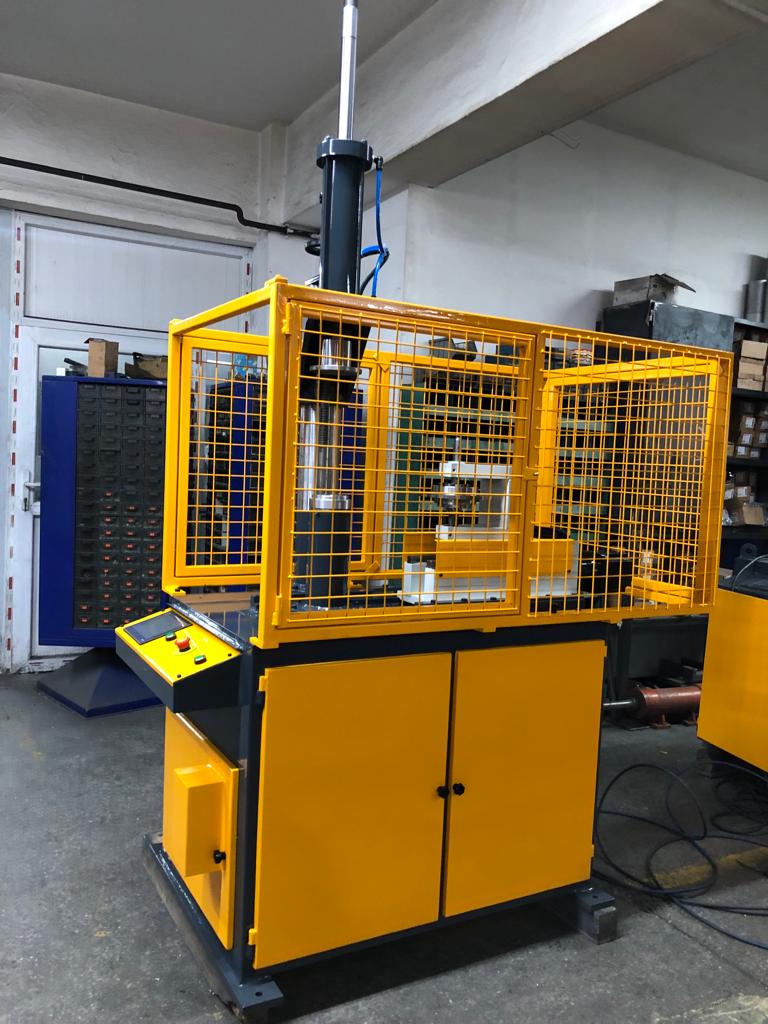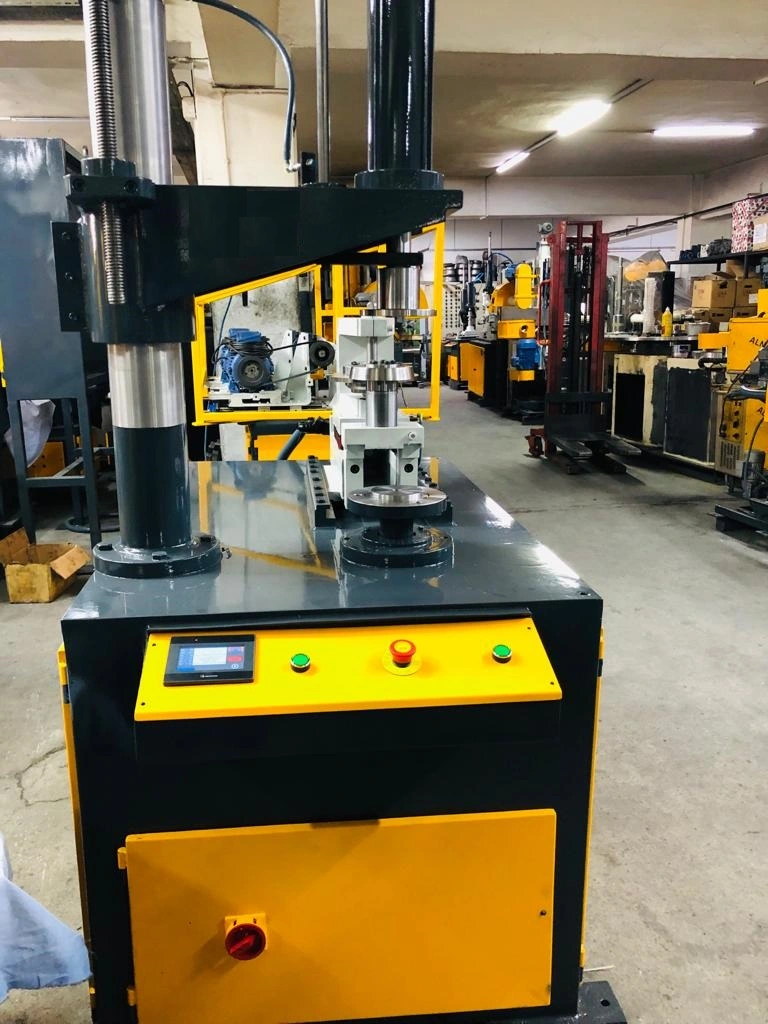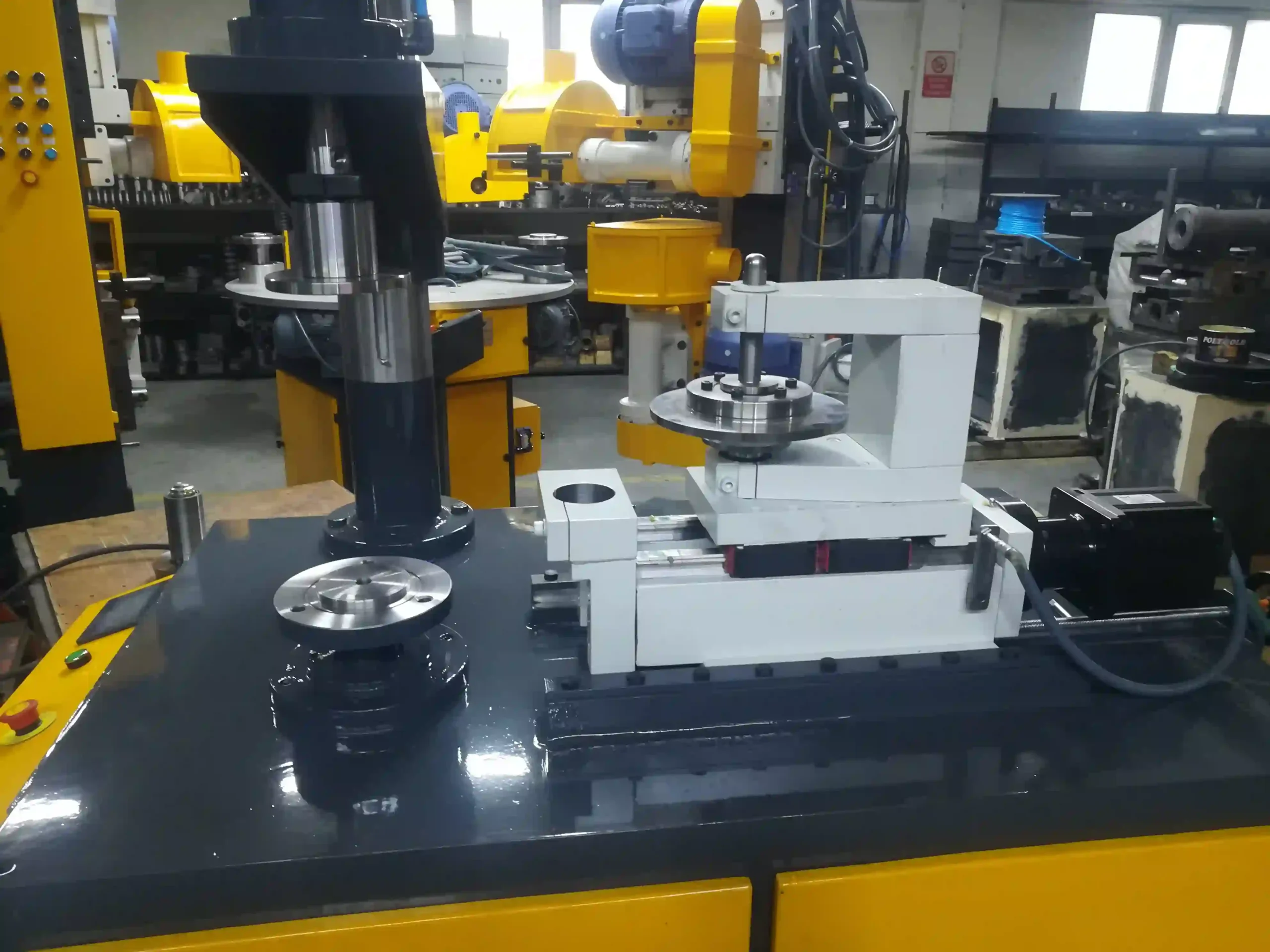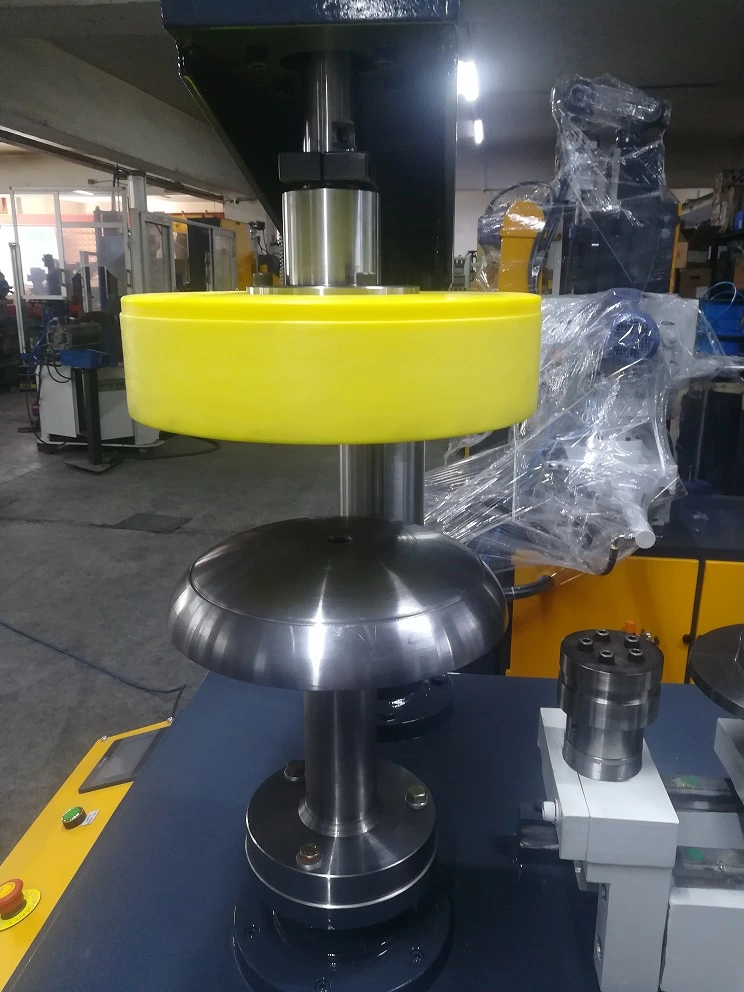
Edge Cutting Trimming Machine for Cookware Production and Edge Cutting Machine for Sheet Metal Pots
Edge cutting machines for sheet metal pots play a vital role in the cookware manufacturing process, ensuring that the edges of pots are trimmed precisely and uniformly, contributing to the overall aesthetics, functionality, and safety of the finished products. These machines utilize various cutting techniques to remove excess material and create smooth, clean edges on pots made from various sheet metal materials, such as stainless steel, aluminum, and enamel-coated steel.
Types of Edge Cutting Machines for Sheet Metal Pots
- Rotary Shearing Machines: Rotary shearing machines employ a rotating blade that continuously trims the edge of the sheet metal pot as it is fed through the machine. The blade can be adjusted to achieve the desired cutting depth and angle, ensuring consistent edge trimming across all pots.
- Guillotine Shearing Machines: Guillotine shearing machines utilize a powerful blade that descends vertically onto the sheet metal pot, cutting through the material with a single stroke. This method is suitable for trimming thicker sheet metal and achieving precise edge cuts.
- Laser Cutting Machines: Laser cutting machines employ a high-intensity laser beam to vaporize the sheet metal, creating a clean, precise edge cut. This method is particularly suitable for intricate designs and complex shapes, offering high accuracy and minimal heat distortion.
- Plasma Cutting Machines: Plasma cutting machines utilize a plasma torch that generates an ionized gas jet to cut through the sheet metal. This method is effective for cutting thicker materials and offers faster cutting speeds compared to laser cutting.
Edge Cutting Machine for Sheet Metal Pots

Edge curling is a sheet metal forming process that involves rolling the edge of a sheet metal part into a curl or flange. This process is often used to improve the appearance, functionality, and safety of sheet metal parts.
Purposes of Edge Curling
- Enhanced Appearance: Edge curling creates a smooth, rounded edge that eliminates sharp corners and improves the overall aesthetics of the sheet metal part. This is particularly beneficial for products that are visible to consumers, such as cookware, appliances, and electronic devices.
- Strengthened Edges: Edge curling reinforces the edges of the sheet metal part, making them more resistant to damage and wear. This is crucial for parts that are subjected to frequent handling, impact, or environmental exposure.
- Improved Safety: Edge curling eliminates sharp, burred edges that can pose a safety hazard to users. This is especially important for parts that are handled manually or come into contact with skin or clothing.
- Wire Encapsulation: Edge curling can be used to encapsulate wires or cables within the sheet metal part, providing protection from damage and enhancing the aesthetics of the product.
- Smooth Transition between Surfaces: Edge curling creates a smooth transition between the edge of the sheet metal part and the adjacent surface, reducing the likelihood of snagging, catching, or tearing.
Methods of Edge Curling
- Roll Forming: Roll forming utilizes a series of rollers to gradually bend the edge of the sheet metal part into a curl. This method is suitable for producing long, continuous curls with consistent dimensions.
- Press Forming: Press forming employs a press to form the curl by pressing the sheet metal part between two dies. This method is suitable for producing complex curl shapes and achieving tighter tolerances.
- Beading Machines: Beading machines utilize a rotating wheel or roller to form the curl by pushing the edge of the sheet metal part against a stationary beading tool. This method is suitable for producing a variety of curl shapes and is often used for curved or irregular edges.
Factors Affecting Edge Curling
- Sheet Metal Material: The properties of the sheet metal material, such as its thickness, strength, and ductility, influence the curling process and the achievable curl shape.
- Curl Dimensions: The desired curl dimensions, including the curl radius, flange width, and curl angle, must be carefully considered to ensure the desired effect and functionality.
- Forming Tooling: The design and accuracy of the forming tools, such as rollers, dies, or beading tools, play a critical role in achieving precise curl dimensions, consistent shapes, and smooth transitions.
- Forming Parameters: The forming parameters, including forming pressure, speed, and temperature, must be controlled to prevent material defects and ensure the integrity of the curl.
Applications of Edge Curling
- Cookware: Edge curling is widely used in the cookware industry to create smooth, rounded edges on pots, pans, and lids, enhancing the appearance and safety of these products.
- Appliances: Edge curling is employed in the manufacturing of appliances to eliminate sharp edges, protect internal components, and provide a smooth transition between surfaces.
- Electronic Devices: Edge curling is used in the production of electronic devices to encapsulate wires, provide protection from external damage, and enhance the aesthetic appeal of the product.
- Automotive Parts: Edge curling is utilized in the automotive industry to strengthen and protect edges of sheet metal parts, such as fenders, doors, and hoods.
- Industrial Equipment: Edge curling is employed in the manufacturing of industrial equipment to enhance safety, prevent snagging, and protect from environmental factors.
Conclusion
Edge curling is a versatile and valuable sheet metal forming process that enhances the appearance, functionality, and safety of sheet metal parts. By carefully selecting the curling method, optimizing forming parameters, and utilizing appropriate tooling, edge curling can achieve precise dimensions, consistent shapes, and smooth transitions, contributing to the success of countless products that rely on curled edges in their daily use.
Key Components of Edge Cutting Machines for Sheet Metal Pots
- Cutting Blade or Laser Beam: The cutting blade or laser beam is the primary component responsible for trimming the edge of the sheet metal pot. It must be sharp and durable to maintain consistent cutting performance.
- Material Feed Mechanism: The material feed mechanism controls the movement of the sheet metal pot through the machine, ensuring accurate positioning for trimming. It may involve rollers, conveyors, or grippers to maintain precise alignment.
- Clamping System: The clamping system secures the sheet metal pot in place during the cutting process, preventing movement and ensuring consistent edge trimming. It may involve pneumatic or hydraulic clamps to provide a firm grip.
- Control Panel: The control panel houses various controls for operating the machine, including start/stop buttons, blade adjustment settings, feed rate control, and safety interlocks.
Benefits of Edge Cutting Machines for Sheet Metal Pots
- Precise and Uniform Trimming: These machines ensure precise and uniform trimming of pot edges, resulting in a consistent and aesthetically pleasing appearance across all pots.
- Efficient and High-Volume Production: Edge cutting machines can process large quantities of pots in a short time, significantly increasing production efficiency compared to manual trimming methods.
- Reduced Material Waste: These machines minimize material waste by trimming only the excess material, reducing production costs and promoting sustainability.
- Improved Safety: Edge cutting machines incorporate safety features, such as guards, interlocks, and emergency stop buttons, to protect workers from potential hazards during operation.
Conclusion
Edge cutting machines for sheet metal pots are essential tools in the cookware manufacturing industry, ensuring that pots meet the standards of quality, aesthetics, and safety. These machines provide precise edge trimming, contribute to efficient production, and enhance worker safety. By utilizing advanced cutting techniques and incorporating innovative features, edge cutting machines play a crucial role in the production of high-quality cookware that is both functional and visually appealing, satisfying the expectations of consumers and upholding the reputation of cookware brands.
Edge Cutting Machine for Sheet Metal Pots is one of the main topics in cookware or kitchenware production, as most of the parts are metal and round, a hydraulic deep drawing press mostly manufactures them. Hydraulic deep drawing presses manufacture pot-shaped parts by deep drawing, a process that forms pot-shaped parts from round blankets. These circle blankets are first manufactured by a machine called https://ems-metalworking.com/sample-page/circle-cutting-machine/
After the circles are cut out, the hydraulic press draws these circles into pots. Those hydraulic press machines can be of various power and dimension ranges such as https://ems-metalworking.com/hydraulic-deep-drawing-press/
The operations related to edge cutting and trimming or edge cutting and forming start exactly here, the pot-shaped parts are taken onto the molds of the edge cutting and forming machine to cut the round edges straight and smooth. Sometimes these edges are also bent or curled inside for a lid or a counter cap to sit in and even weld.

The knife of an edge cutting machine is manufactured of high carbon steel to withstand the wear caused by the cutting. The cutting of a metal round part is carried out by a cycle frequency of 8-10 parts in a minute. This operation can be performed on parts such as pressure cookers, metal pots, pans, fire extinguishers, general cookware, and kitchenware parts, lids, water heaters and etc
Edge curling of sheet metal parts
Edge curling is a sheet metal forming process that involves rolling the edge of a sheet metal part into a curl or flange. This process is often used to improve the appearance, functionality, and safety of sheet metal parts.
Purposes of Edge Curling
- Enhanced Appearance: Edge curling creates a smooth, rounded edge that eliminates sharp corners and improves the overall aesthetics of the sheet metal part. This is particularly beneficial for products that are visible to consumers, such as cookware, appliances, and electronic devices.
- Strengthened Edges: Edge curling reinforces the edges of the sheet metal part, making them more resistant to damage and wear. This is crucial for parts that are subjected to frequent handling, impact, or environmental exposure.
- Improved Safety: Edge curling eliminates sharp, burred edges that can pose a safety hazard to users. This is especially important for parts that are handled manually or come into contact with skin or clothing.
- Wire Encapsulation: Edge curling can be used to encapsulate wires or cables within the sheet metal part, providing protection from damage and enhancing the aesthetics of the product.
- Smooth Transition between Surfaces: Edge curling creates a smooth transition between the edge of the sheet metal part and the adjacent surface, reducing the likelihood of snagging, catching, or tearing.
Methods of Edge Curling
- Roll Forming: Roll forming utilizes a series of rollers to gradually bend the edge of the sheet metal part into a curl. This method is suitable for producing long, continuous curls with consistent dimensions.
- Press Forming: Press forming employs a press to form the curl by pressing the sheet metal part between two dies. This method is suitable for producing complex curl shapes and achieving tighter tolerances.
- Beading Machines: Beading machines utilize a rotating wheel or roller to form the curl by pushing the edge of the sheet metal part against a stationary beading tool. This method is suitable for producing a variety of curl shapes and is often used for curved or irregular edges.
Factors Affecting Edge Curling
- Sheet Metal Material: The properties of the sheet metal material, such as its thickness, strength, and ductility, influence the curling process and the achievable curl shape.
- Curl Dimensions: The desired curl dimensions, including the curl radius, flange width, and curl angle, must be carefully considered to ensure the desired effect and functionality.
- Forming Tooling: The design and accuracy of the forming tools, such as rollers, dies, or beading tools, play a critical role in achieving precise curl dimensions, consistent shapes, and smooth transitions.
- Forming Parameters: The forming parameters, including forming pressure, speed, and temperature, must be controlled to prevent material defects and ensure the integrity of the curl.
Applications of Edge Curling
- Cookware: Edge curling is widely used in the cookware industry to create smooth, rounded edges on pots, pans, and lids, enhancing the appearance and safety of these products.
- Appliances: Edge curling is employed in the manufacturing of appliances to eliminate sharp edges, protect internal components, and provide a smooth transition between surfaces.
- Electronic Devices: Edge curling is used in the production of electronic devices to encapsulate wires, provide protection from external damage, and enhance the aesthetic appeal of the product.
- Automotive Parts: Edge curling is utilized in the automotive industry to strengthen and protect edges of sheet metal parts, such as fenders, doors, and hoods.
- Industrial Equipment: Edge curling is employed in the manufacturing of industrial equipment to enhance safety, prevent snagging, and protect from environmental factors.
Conclusion
Edge curling is a versatile and valuable sheet metal forming process that enhances the appearance, functionality, and safety of sheet metal parts. By carefully selecting the curling method, optimizing forming parameters, and utilizing appropriate tooling, edge curling can achieve precise dimensions, consistent shapes, and smooth transitions, contributing to the success of countless products that rely on curled edges in their daily use.
Edge curling is a finishing operation of edge-cutting trimming machines where curling is carried out by a special edge curling tool. Curling here is determined as bending the rims of a round part inside or outside by curling it. This finishing operation is usually needed where there will be a tight fixing of one part onto another.
After the edge cutting and trimming process, the handles are riveted to the parts and go to the finishing process. For the riveting machines, you can get more information from the link below
An edge cutting machine for sheet metal pots is a specialized machine used to trim and shape the edges of sheet metal pots. It is an essential part of the cookware manufacturing process and ensures that the edges of the pots are smooth and uniform, which is necessary for the safety and functionality of the finished product.
The machine works by using a sharp blade to cut the excess material from the edges of the pots. The blade is usually made of high-quality steel and can be adjusted to cut at various angles and depths. The machine is controlled by a computer or a skilled operator who ensures that the cuts are accurate and precise.
Edge Cutting Machine for Sheet Metal Parts

Some edge cutting machines for sheet metal pots also include additional features such as automatic feeders, which can help to increase the efficiency of the manufacturing process. These machines can also be customized to work with various sizes and shapes of pots, making them versatile and adaptable to different production needs.
Edge cutting machines for sheet metal pots are available in various sizes and configurations, depending on the specific requirements of the manufacturing process. Some machines are designed to handle large volumes of pots, while others are more suitable for smaller production runs.
One common type of edge cutting machine for sheet metal pots is the rotary cutter. This machine uses a rotating blade to trim the edges of the pots. The blade is attached to a motor, which can be adjusted to control the speed and depth of the cut. Rotary cutters are often used in high-volume manufacturing settings, where speed and efficiency are critical.
Another type of edge cutting machine for sheet metal pots is the guillotine cutter. This machine uses a stationary blade to cut the edges of the pots. The pot is positioned under the blade, and the blade is lowered to make the cut. Guillotine cutters are typically used for smaller production runs, where precision and accuracy are more important than speed.
Overall, an edge cutting machine for sheet metal pots is an essential part of the cookware manufacturing process. It helps to ensure that the finished products are safe, functional, and aesthetically pleasing, and can contribute to the overall efficiency and productivity of the manufacturing operation.
EMS Metalworking Machinery
We design, manufacture and assembly metalworking machinery such as:
- Hydraulic transfer press
- Glass mosaic press
- Hydraulic deep drawing press
- Casting press
- Hydraulic cold forming press
- Hydroforming press
- Composite press
- Silicone rubber moulding press
- Brake pad press
- Melamine press
- SMC & BMC Press
- Labrotaroy press
- Edge cutting trimming machine
- Edge curling machine
- Trimming beading machine
- Trimming joggling machine
- Cookware production line
- Pipe bending machine
- Profile bending machine
- Bandsaw for metal
- Cylindrical welding machine
- Horizontal pres and cookware
- Kitchenware, hotelware
- Bakeware and cuttlery production machinery
as a complete line as well as an individual machine such as:
- Edge cutting trimming beading machines
- Polishing and grinding machines for pot and pans
- Hydraulic drawing presses
- Circle blanking machines
- Riveting machine
- Hole punching machines
- Press feeding machine
You can check our machinery at work at: EMS Metalworking Machinery – YouTube
Applications:
- Beading and ribbing
- Flanging
- Trimming
- Curling
- Lock-seaming
- Ribbing
- Flange-punching
